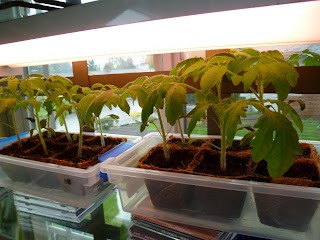I just finished reading the book, "Potato, A history of the Propitious Esculent", by John Reader. The potato has a fascinating history. They started in the Andes, in Peru, Chile, and Argentina, and were one of the first plants to be domesticated. They fueled the Inca empire, but Spanish invaders destroyed the Inca civilization. I guess throwing potatoes isn't as effective as horses, metal weapons, and smallpox. The potato then used the Spanish to spread itself around Europe, and the world, fueling population explosions and all sorts of history. All of which inspired me to become more ambitious about potato barrels. The starts that I planted in January grew above the soil line, frosted, and looked dead. I gave up looking. Yesterday I saw they have sent out new shoots. About half survived. They have healthy-looking, thick, dark green leaves on stout stems. They are barely above the soil line. There were some remaining spaces. I bought a tiny bag of chitted potatoes, "Satina" variety, and planted the empty spaces with starts.
Satina is a small, oval, yellow fleshed, nice looking potato. The bin at the plant store only had a few remaining starts, but that's all I wanted. The starts cost 30 cents.

Feeling ambitions about growing potatoes in barrels, and with good experience last year, I wanted to add more. I found this plastic container for $7.99, much, much cheaper than the wooden containers and should last as long or longer. It might over heat, mid summer, but I have a plan for that. Apply shiny foil to the outside when it starts to become hot. That will lower soil temperature by 10 or more degrees, from my measurements a few years ago. Meanwhile, the dark plastic should soak up some heat and might speed early growth. I got out the electric drill and drilled about a dozen 3/4 inch holes in the bottom for drainage. Easy. Then added about 6 inches of potting soil. I planted a different variety, "Carmine." According to the clerk, carmine is red inside and out. I could not find information on this variety on the internet, so we'll see. I covered with about 3 inches of potting soil. When they grow to about a foot tall, I'll add anouther 6 inches, and repeat when they grow another foot.

It's hard not to plant too many. These are spaced about 9 inches apart. That might be too close for optimum growth, but is a little further apart than last year, and they did fine. Looking at my blog last year, I'm about 5 weeks behind planting the potatoes. The trees are blooming late too - maybe 3 or 4 weeks late. I think they will still do fine.
 The trees are lovely. If they did not have peaches, they would be sold purely as ornamentals. That is, except here in the Maritime Pacific Northwest, where ornamentals that get leaf curl are not needed.
The trees are lovely. If they did not have peaches, they would be sold purely as ornamentals. That is, except here in the Maritime Pacific Northwest, where ornamentals that get leaf curl are not needed.  It lookes like the infestation could be small. It's on some leaves. Not all tips. Leave curl results in a very pretty appearance at this stage. The leaves have a maroon variegated edge and start to become curly. Evil is sometimes quite pretty. It usually gets worse as the leaves grow. Wait and see. Treatment now is not helpful. Maybe the midwinter copper spray was helpful. I try not to get my hopes up. It would be great if that method worked.
It lookes like the infestation could be small. It's on some leaves. Not all tips. Leave curl results in a very pretty appearance at this stage. The leaves have a maroon variegated edge and start to become curly. Evil is sometimes quite pretty. It usually gets worse as the leaves grow. Wait and see. Treatment now is not helpful. Maybe the midwinter copper spray was helpful. I try not to get my hopes up. It would be great if that method worked.








